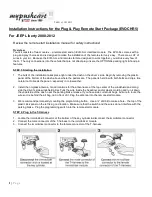
Control of a Vehicle
You have three systems that make your vehicle
go where you want it to go. They are the brakes,
the steering, and the accelerator. All three
systems have to do their work at the places where
the tires meet the road.
Sometimes, as when you are driving on snow
or ice, it is easy to ask more of those control
systems than the tires and road can provide.
That means you can lose control of your vehicle.
See StabiliTrak
®
System on page 367.
Adding non-GM accessories can affect your
vehicle’s performance. See Accessories and
Modifications on page 450.
Braking
See Brake System Warning Light on page 250.
Braking action involves perception time and
reaction time.
First, you have to decide to push on the brake
pedal. That is perception time. Then you have to
bring up your foot and do it. That is reaction time.
Average reaction time is about three-fourths of a
second. But that is only an average. It might
be less with one driver and as long as two or
three seconds or more with another. Age, physical
condition, alertness, coordination, and eyesight
all play a part. So do alcohol, drugs, and
frustration. But even in three-fourths of a second,
a vehicle moving at 60 mph (100 km/h) travels
66 feet (20 m). That could be a lot of distance in an
emergency, so keeping enough space between
your vehicle and others is important.
And, of course, actual stopping distances vary
greatly with the surface of the road, whether it is
pavement or gravel; the condition of the road,
whether it is wet, dry, or icy; tire tread; the
condition of the brakes; the weight of the vehicle;
and the amount of brake force applied.
364
Summary of Contents for 2007 Yukon XL
Page 6: ...These are some examples of symbols that may be found on the vehicle 6...
Page 40: ...Put someone on it Get it up to speed Then stop the vehicle The rider does not stop 40...
Page 114: ...NOTES 114...
Page 202: ...Instrument Panel Overview United States version shown Canada similar 202...
Page 358: ...NOTES 358...
Page 591: ...Engine Drive Belt Routing 591...
















































